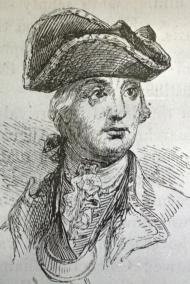1/22/1781
To General
Robert Howe
"Sir: You are to take the command of the detachment, which
has been ordered to march from this post against the mutineers of
the Jersey line. You will rendezvous the whole of your command at
Ringwood or Pompton as you find best from circumstances. The object
of your detachment is to compel the mutineers to unconditional
submission, and I am to desire you will grant no terms while they
are with arms in their hands in a state of resistance. The manner
of executing this I leave to your discretion according to
circumstances. If you succeed in compelling the revolted troops to
a surrender you will instantly execute a few of the most active and
most incendiary leaders.
You will endeavour to collect such of the Jersey troops to your
standard as have not followed the pernicious example of their
associates, and you will also try to avail yourself of the services
of the Militia, representing to them how dangerous to civil liberty
the precedent is of armed soldiers dictating terms to their
country.
You will open a
correspondence with Colonels Dayton and Shreve of the Jersey line
and Col Freelinghousen of the Militia or any
others."
-- G.
Washington

In 1732, Robert Howe was born in Brunswick County, North
Carolina. He emerged as the colonies’ highest-ranking officer
during the Revolutionary War. In November 1786, Howe died at his
home in Brunswick County.
His military career began in 1754, when appointed Captain of the
Bladen County militia. In 1756, Howe was appointed Justice of the
Peace and was elected to represent Bladen County in the General
Assembly from 1760 to 1775.
While in the General Assembly, Howe and Royal Governor William
Tryon established a friendship. In 1761, Tryon appointed Howe to
the Supreme Court for the Wilmington District, and in 1766, to the
Court of Exchequer. From 1765 to 1767 and from 1769 to 1773, Howe
commanded Fort Johnston. During the 1760s, Governor Tryon called on
Howe and his Fort Johnston troops to put down the Regulator
Rebellion.
During the 1770s, Royal Governor Josiah Martin and Howe
frequently disagreed. In 1771, Martin replaced Governor Tryon and
shortly afterward removed Howe from the Court of Exchequer; in
1773, he relinquished Howe of command of Fort Johnston. The
attachment clause controversy further divided Howe and Martin. The
provincial government deplored the attachment clause, which allowed
creditors to “attach property owned in North Carolina by
non-residents . . . to satisfy their debts.” Governor Martin
supported the decision to remove the clause, but colonial lawmakers
were determined to keep the law intact. While leading the movement
to keep the attachment clause, Howe associated with the Sons of
Liberty and the American struggle for independence.
North Carolina’s General Assembly met in 1773 and established a
Committee of Correspondence. Howe was one of nine committee members
assigned to investigate Parliamentary Acts that “may relate to or
effect the British Colonies in America.” The Committee reported
their findings to all colonies and united the fight for America’s
freedom.
In 1775, Howe trained the Brunswick County militia, received a
colonel’s appointment, and assumed command of the Second North
Carolina Continentals. Howe led his 428 officers and men to
Norfolk, Virginia to reinforce Colonel William Woodford’s army,
then battling Lord Dunmore. He assumed command of the American
troops and defeated Lord Dunmore. Although Howe had proved his
military prowess, the Second North Carolina Regiment disbanded
shortly after the battle in Norfolk.
Afterwards, Howe was appointed military advisor for North
Carolina’s Provincial Congress. In 1777, he led North Carolina
troops to meet Major General Charles Lee, commander of the Southern
Department. Now a major general, Howe was the highest ranking North
Carolinian in the Continental Army. When General Lee left the
Southern Department, James Moore assumed command. However, in the
spring of 1777, Moore was ordered to North Carolina and Howe became
Commander of the Southern Department and the highest-ranking
officer in the South.
As Commander of the Southern Department, Howe was to defend the
southern colonies. In the summer of 1778, Howe led the Continentals
to the Georgia-Florida border to attack the British troops at St.
Augustine, Florida. Fearing defeat, Howe urged Congress to abandon
the campaign. But Congress persisted. After several months of
chasing the British, Howe retreated northward. The campaign in
Florida was disastrous for Howe. His inability to unify command
undermined American ability to win.
Howe’s reputation was tarnished by his defeat in Florida, so he
desperately wanted to prove his worth. He led the troops of the
Southern Department to defend Savannah, Georgia. Howe lost the city
in December 1778, however, after a surprise attack by
Lieutenant-Colonel Archibald Campbell. Soon after, all of Georgia
fell to the British and Howe was relieved as commander of the
Southern Department.
Beginning in 1779, Howe served with General George Washington on
the Hudson, commanded troops protecting the Connecticut border at
Ridgefield, and in 1780, commanded Fort West Point. Although
Congress appointed him in 1785 as part of a commission to negotiate
the land in Ohio with western Indians, Howe returned to North
Carolina, where the General Assembly passed a resolution thanking
him for his devotion to the state. In hopes of gaining a state
legislative seat, Howe campaigned in Brunswick County, but in
November 1786, he suffered a fever and died.